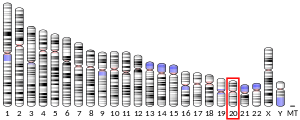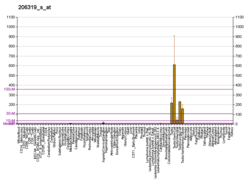SPINLW1
Eppin is a protein that in humans is encoded by the SPINLW1 gene.[5][6][7]
This gene encodes an epididymal protease inhibitor, which contains both kunitz-type and WAP-type four-disulfide core (WFDC) protease inhibitor consensus sequences. Most WFDC genes are localized to chromosome 20q12-q13 in two clusters: centromeric and telomeric. This gene is a member of the WFDC gene family and belongs to the telomeric cluster. Alternatively spliced transcript variants encoding distinct isoforms have been found for this gene.[7]
References
- GRCh38: Ensembl release 89: ENSG00000101448 - Ensembl, May 2017
- GRCm38: Ensembl release 89: ENSMUSG00000074595 - Ensembl, May 2017
- "Human PubMed Reference:". National Center for Biotechnology Information, U.S. National Library of Medicine.
- "Mouse PubMed Reference:". National Center for Biotechnology Information, U.S. National Library of Medicine.
- Richardson RT, Sivashanmugam P, Hall SH, Hamil KG, Moore PA, Ruben SM, French FS, O'Rand M (Jun 2001). "Cloning and sequencing of human Eppin: a novel family of protease inhibitors expressed in the epididymis and testis". Gene. 270 (1–2): 93–102. doi:10.1016/S0378-1119(01)00462-0. PMID 11404006.
- Clauss A, Lilja H, Lundwall A (Nov 2002). "A locus on human chromosome 20 contains several genes expressing protease inhibitor domains with homology to whey acidic protein". Biochem J. 368 (Pt 1): 233–42. doi:10.1042/BJ20020869. PMC 1222987. PMID 12206714.
- "Entrez Gene: SPINLW1 serine peptidase inhibitor-like, with Kunitz and WAP domains 1 (eppin)".
Further reading
- Wang Z, Widgren EE, Sivashanmugam P, et al. (2005). "Association of eppin with semenogelin on human spermatozoa". Biol. Reprod. 72 (5): 1064–70. doi:10.1095/biolreprod.104.036483. PMID 15590901.
- Gerhard DS, Wagner L, Feingold EA, et al. (2004). "The status, quality, and expansion of the NIH full-length cDNA project: the Mammalian Gene Collection (MGC)". Genome Res. 14 (10B): 2121–7. doi:10.1101/gr.2596504. PMC 528928. PMID 15489334.
- Yenugu S, Richardson RT, Sivashanmugam P, et al. (2005). "Antimicrobial activity of human EPPIN, an androgen-regulated, sperm-bound protein with a whey acidic protein motif". Biol. Reprod. 71 (5): 1484–90. doi:10.1095/biolreprod.104.031567. PMID 15229136.
- Sivashanmugam P, Hall SH, Hamil KG, et al. (2003). "Characterization of mouse Eppin and a gene cluster of similar protease inhibitors on mouse chromosome 2". Gene. 312: 125–34. doi:10.1016/S0378-1119(03)00608-5. PMID 12909348.
- Strausberg RL, Feingold EA, Grouse LH, et al. (2003). "Generation and initial analysis of more than 15,000 full-length human and mouse cDNA sequences". Proc. Natl. Acad. Sci. U.S.A. 99 (26): 16899–903. doi:10.1073/pnas.242603899. PMC 139241. PMID 12477932.
- Deloukas P, Matthews LH, Ashurst J, et al. (2002). "The DNA sequence and comparative analysis of human chromosome 20". Nature. 414 (6866): 865–71. doi:10.1038/414865a. PMID 11780052.
This article is issued from Wikipedia. The text is licensed under Creative Commons - Attribution - Sharealike. Additional terms may apply for the media files.





